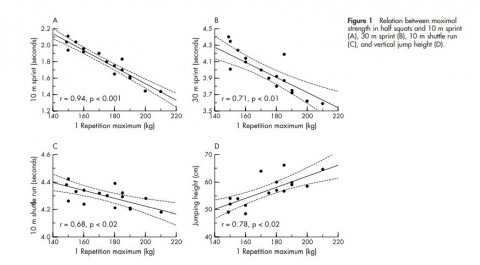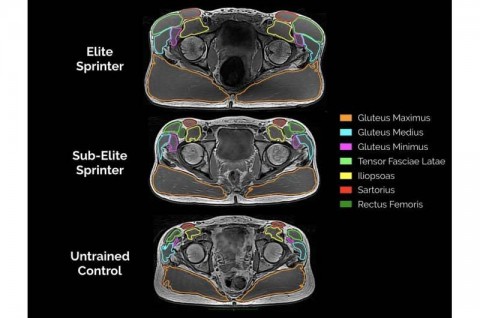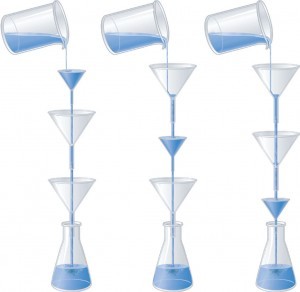Sprinting and vertical jump performance are important skills in the game of soccer. In terms of sprinting, a soccer player will sprint every 90 s during a match. These sprints average about 2-4 seconds and can account for up to 11% of the distance covered during a match. And with vertical jump performance think of all the times a player will go up for a header, off a corner or as a keeper exploding up to deflect a ball over the cross bar. So while intuitively it makes sense that sprinting and jumping are important in soccer it would be beneficial to know how important they are. And from a strength and conditioning perspective, how important is a strength exercise like the back squat, to improving these qualities? A group of researchers looked to answer these questions and called upon a Norwegian pro soccer club to participate in the study. 17 male soccer players from Rosenborg FC, average age 25 years, were put through a number of performance tests to see how what the relationship was between the 1 RM half squat with sprinting and jumping. Rosenborg FC is a top flight team in Norway having won their league a number of times and participating in the Champions League. For the 1 RM back half squat players did barbell back squats to 90 degrees of knee flexion, adding load until a 1 RM was determined. Once they were warmed up, most players took three to six sets to determine their 1 RM. For the sprint test, players ran from 0-30 m with photocell timing gates. Splits were recorded at each 10 m and the players rested 5 minutes between the two attempts. The best sprint time was included in the data presented. And for the vertical jump a force platform was...
Built for Show - And for Go
- Chris Collins
- Fitness
- 1988 Hits
- 0 Comments
-
There seems to be a school of thought when it comes to resistance training that you're either training for performance or for aesthetics. It's either bodybuilding or strength and conditiong. Built for show or for go. It was as though the two goals were mutually exclusive and could not overlap. Meatheads would mock those who couldn't build 20 inch arms. And athletes would point out all the gym rats that trip over their own feet during a game of football. But is that the case? If you train for hypertrophy i.e. size, does that mean you'll be useless on the playing field? New research says that's not the case. The study look at muscle volume and strength and compared this among three groups 1) elite sprinters n= 5, 2) sub-elite sprinters n= 26, and untrained controls n=11. All study subjects were male. Elite sprinters were defined as though that could run a 10.10 second 100 meter and sub-elite as though that could run the 100 m in 10.80 seconds. To put in perspective how fast a 10.10 second 100 metre is, only four Canadians have ever run a sub 10 second 100 m including Olympic champion Donovan Bailey and Olympic bronze medallist Andre De Grasse. The study subjects underwent MRIs to determine muscle volume of 23 lower limb muscles and 5 functional muscles. These were then correlated to 100 m times and isometric strength. What they found was that the muscularity of elite sprinters was greater in elite sprinters than sub-elite and both were greater than the controls. In particular the hip extensors showed the biggest difference among the groups and this accounted for 31-48% of the variability in 100 m times. Of the hip extensors it turns out the gluteus maximus alone accounted for 34-44 % of variance in 100...
The Importance of Lower-Limb Joints on Sprinting
- Chris Collins
- Fitness
- 1801 Hits
- 0 Comments
-
Did you ever take chemistry in school? If so, you may remember something known as the rate limiting step. What this means is that when there's a chemical reaction the speed of the reaction may be limited by a particular element. Increasing the concentration of this element allows the entire reaction to happen more quickly. [caption id="attachment_5569" align="aligncenter" width="300"] With the 3 pours, the first funnel will be limited, followed by the middle series and then the 3rd series of funnel. The flow rate in each is limited by the smallest funnel. It's important to know the rate limiting or determining step because then we know where our efforts will generate a better result. Let's look a different example to see how this works. Imagine a busy restaurant that measures each day's success by the number of tables turned over. There will be a maitre-d, a hostess, a server, sous-chefs, head-chefs, bussers and dishwashers. If the dishwasher doesn't show up for work eventually the plates pile up and there will no clean plates to set a new table. Everything backs up at this point. And it doesn't matter if everyone else does a little bit more because the dishes are still piling up, not getting washed and tables are not getting turned over. We can know appreciate that when we're looking to achieve a goal there may be something that limits the outcome. With sprinting for example, we know there are contributions from the lower body joints i.e. the ankle, knee and hip. When walking there is a contribution from each of these joints. As we progress from walking to sprinting is the increased role of these joints proportional? Or are certain joints prioritized? A recent study looked to answer this question. Researchers looked at the involvement of the ankle, knee...
Top 12 Reasons to Run
- Chris Collins
- Fitness
- 2114 Hits
- 0 Comments
-
Are you a runner? It's kind of one of those questions that generates a pretty clear answer. For example, for runners this is what they do for exercise. It doesn't matter what the weather is. it doesn't matter if they have their training partner with them. And it doesn't matter if they are away from home. Runners will always time time and an opportunity to run. So regardless of whether somebody is a runner or not you have to appreciate the mindset runners bring to their sport. But there are a number of other benefits to include running in your training. Here are the Top 12 Reasons to Run. #1 - You can do it anywhereHow many times have been away from home and not worked out. Maybe the hotel gym was non existent. Or you're a cyclist and you didn't bring your bike on the trip. Or for whatever reason there wasn't an opportunity to train and stay active. It's pretty hard to use the same argument with running. Wherever you are in the world there is space to run. Maybe this is outdoors. Or it might be an indoor track or stairs in your hotel. Regardless it's relatively easy to find an opportunity to run. And running shoes are about the easiest thing to pack. Even if you forget to pack some shoes you can pick up new ones on vacation and still get in a run. #2 - Return on investmentWhen we train it should be purposeful and enjoyable. In terms of having a purpose, the #1 goal of people who go to the gym is weight loss or more specifically, fat loss. Running can burn anywhere from 400-600 calories in an hour depending on the intensity. Not only are you improving your cardiovascular fitness but you are getting leaner in the...
The Myth of Triple Extension
- Chris Collins
- Fitness
- 2136 Hits
- 0 Comments
-
Last weekend Graeme and I had the opportunity to attend a speed coaching clinic with Derek Evely. Derek was the Leeborough Centre Director of UK Athletics from 2009-2012 prior to the London Olympic games in 2012. He has coached a number of number of Olympic podium athletes and continues to work with some of the best hammer throwers in the world. Derek was a wealth of knowledge and a great presenter. His delivery of the content was professional and allowed for discussion and questions. At one point he even Skyped in 3 of the best sprint and hurdles coaches in the world with Kevin Tyler, Andreas Behm and Stu McMillan from Altis in Arizona. If you're not in sprinting circles these names probably don't mean too much. But these four individuals represent the best of the best when it comes to sprinting knowledge and coaching ability. And it was definitely a special opportunity to listen to them and be able to ask questions. And let's face it...every athlete wants more speed. Actually I'm not even an athlete but I still want to move quickly. There's just something about being able to accelerate and hit a top end speed better than most that appeals. This might have to do with having a burst of speed a the end of a road race, of being able to win battles in team sports (i.e. basketball, football, soccer etc) or simply wanting to look more like a sprinter than a runner. [caption id="attachment_4878" align="aligncenter" width="299"] Running versus Sprinting - Which body type do you prefer? So if we can agree that all athletes want more speed and that most general fitness clients wouldn't mind moving more quickly as well than we need...
Are 800s the Ultimate Fitness Test?
- Chris Collins
- Fitness
- Training
- 1716 Hits
- 0 Comments
-
Have you ever run 800s? If you've competed in track and field there's a good chance you may have some experience with this distance. And therefore you know how awful this event can be. Why is it so awful? Well it's too long of a distance to sprint and not long of a distance to really pace yourself. It's basically 2 to 3 minutes of pure physical discomfort. And if you're into that sort of thing than you've found the perfect workout to inflict as much pain and discomfort as you can handle. But there are a few other reasons I like the 800s as a training distance as it provides valuable feedback as to what you should workout on to improve performance. Below are 4 Benefits of Running 800s. Benefit #1 - Measure of Overall SpeedThe nice thing about 800s is that you do two laps of a track oval to achieve this distance. And based on your time you get a bit of an idea of your overall speed. If you want to know how you compare to the world record you can do two laps and see how close to 1 minute 40 seconds which is the current world record. Are you within 30 seconds of the world record? 60 seconds? More? Test yourself and see how your overall speed ranks. Benefit #2 - Measure of Your PaceAs I mentioned at the beginning you can't sprint an 800 m nor can you pace yourself. And after running this distance a few times you'll quickly learn a bit about your pace. For example, let's say your total time was three minutes which is not too shabby. And your splits were 1 min 40 for the first lap and 1 min 20 for the second. Since most people tire in...
8 Week 10 K Running Clinic
- Chris Collins
- Training
- 1552 Hits
- 2 Comments
-
Starting next Monday August 13 Okanagan Peak Performance Inc is proud to present its 8 Week 10 K Running Clinic. So what brought this about? Well there are lots of people who start running programs. And fewer complete them. And fewer stay injury free. And fewer get faster over the years. Are you one of these people? Have you given running a shot in the past? Have you suffered an injury? Or found that the time you needed to invest to running became too great? Chances are you may have answered 'yes' to one of these questions. So we created the 8 Week 10 K Running Clinic - The efficient, pain-free way to running your best 10 K. Here's what's included. 1. Complementary Gym Based Workouts - Have you ever noticed people either lift or they run? But they don't do both. But to have the best health we need both muscular strength and a well developed cardiovascular system. And since these two types of training are often separate we tend to fall short of our full potential. Or we see people make the effort to incorporate resistance training with their run program and they select exercises like leg presses, leg extensions and leg curls. Sure these are lower body exercises, which should be beneficial for running but definitely not your best choice. We'll show how to do better exercises specific to running. 2. Efficient Run Programs - If you've tried running in the past you've noticed there is a time commitment required. And the more you run the more time you need to invest. I remember reading in Why We Get Fat by Gary Taubes that if a women in her 20's runs 3 miles per day, she will have to run 15 miles per day in her 40's to keep the...




